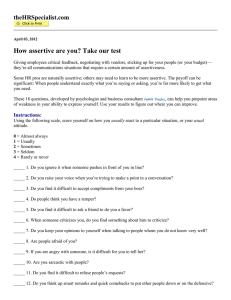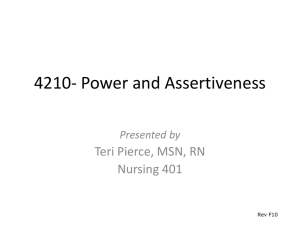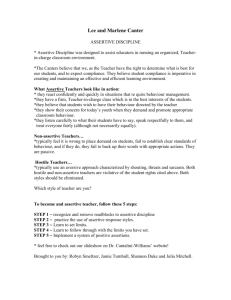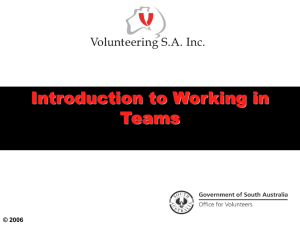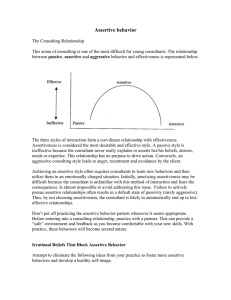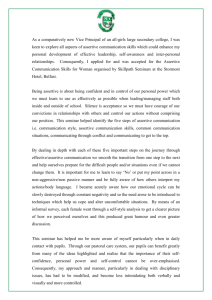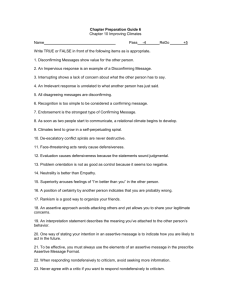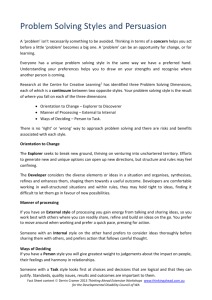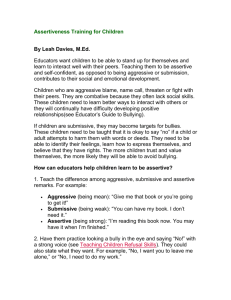Assertive Communication - Wilson Community College
advertisement
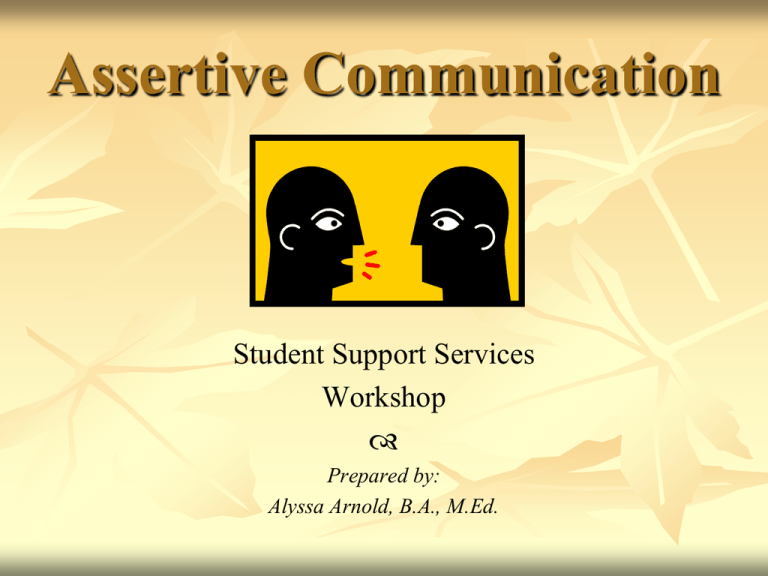
Assertive Communication
Student Support Services
Workshop
Prepared by:
Alyssa Arnold, B.A., M.Ed.
Do you…
Have trouble saying no, even when you really
should?
Feel like people walk all over you?
Have trouble expressing your thoughts and
feelings?
Want to learn how to stand up for yourself and
take charge?
Have trouble keeping your temper under
control?
If you answered yes to any of the above questions,
you might find it helpful to learn about assertive
communication.
What is Assertiveness?
It is the ability to honestly
express your opinions,
feelings, attitudes, and
rights -- without undue
anxiety -- in a way that
doesn’t infringe on the
rights of others.
It is not aggressiveness, it’s
a middle ground between
being a bully and a
doormat.
Why is Assertiveness Important?
If you don’t know how to be assertive, you might
experience the following:
Depression: This comes from anger turned
inward. It can give you a sense of being
helpless, hopeless, with no control over your
life.
Resentment: Anger at others for manipulating
or taking advantage of me.
Frustration: How could I be such a wimp? Why
did I let someone victimize me?
Other problems…
Temper/Violence: If you can’t express anger
appropriately, it builds up until it blows.
Anxiety: Which leads to avoidance. If you
begin to avoid situations or people that you
know will make you uncomfortable, you may
miss out on fun activities, job opportunities,
relationships, and lots of other opportunities.
More problems…
Poor relationships of all kinds: Non-assertive
people are often unable to express emotions,
positive or negative. It’s murder in a
relationship when the partners can’t tell each
other what they want and need, and how the
other person affects them. The same is true
for friendships and work relationships.
Even more problems…
Physical complaints: Headaches, ulcers,
high blood pressure. We all know what
stress does to our bodies.
Assertiveness, when it becomes a habit, is a
great stress reliever
How to be Effectively Assertive
Use “I” statements. Example: “I’d like to be
able to tell my stories without interruption.”
instead of “You’re always interrupting my
stories!”
Use facts, not judgments. Example: “Your
punctuation needs work and your formatting
is inconsistent.” instead of “This is sloppy
work.” or “Did you know that shirt has some
spots?” instead of “You’re not going out
looking like THAT, are you?”
{Effectively Assertive}
Express ownership of your thoughts,
feelings, and opinions. Example: “I get
angry when he breaks his promises” instead
of “He makes me angry” or “ I believe the
best policy is to…” instead of “The only
sensible thing is to…”
Make clear & direct requests. Don’t invite
the person to say no. Example: “Will you
please…?” Instead of “Would you mind…?”
or “Why don’t you…?”
Special Techniques for Difficult
Situations
Broken record: Keep repeating your point,
using a low-level, pleasant voice. Don’t get
pulled into arguing or trying to explain
yourself.
Fogging: This is a way to deflect negative
criticism. You agree with some of the fact, but
you retain the right to choose your behavior.
Example: You: “Mom, you should wear a
longer skirt. It’s the style now.” Mom: “You’re
right, skirts are longer now.” Mom agrees with
you but, she still reserves the right to not
change her skirt length and wears it the way
she wants.
{Techniques for Difficult Situations}
Content to Process Shift: When someone is
trying to confuse the issue. Stop talking about
the problem and bring up how the person is
behaving right now. Example: “You’re getting
off the point. I’m starting to feel frustrated
because I feel like you’re not listening.”
Defusing: Letting someone cool down before
discussing an issue. Example: “I can see that
you’re upset. Let’s talk about this later.” Also,
if they try to stay with it, you have the right to
walk away.
{Techniques for Difficult Situations}
Summarization: This helps to make sure
you’re understanding the other person.
Example: “So what you’re trying to tell me
is …”
Specificity: It is really important to be very
clear about what you want done. This helps
prevent distractions. Example: “The thing I
really wish is that you’d pick your clothes
up off the floor.”
Final Points:
A common problem in communication is
caused by trying to read people’s minds or
expecting them to read ours.
If we want people to respond to our ideas and
needs, we have to be able to express them in a
way that will make them want to respond
nicely.
If it’s really scary to think about being
assertive, try it first with people you don’t
know.
Think of someone you know who is assertive
and pretend you are that person.
Once you become comfortable with
assertive behaviors in less threatening
situations, you can crank it up a notch and
use it all the time.
When assertiveness becomes a habit, you
will wonder how you ever got along before
you started using it.
The nicest thing about all of this is that
after you’ve become truly assertive, you
probably won’t need to use these
techniques very much.
As people practice assertive
communication, you can almost see that
little spark of self-respect glimmer,
flicker, take hold, and burst into flame.
People can sense it when you respect
yourself, and they will treat you with
respect. And that is the ultimate goal of
assertive communication.
*To get credit for this Workshop*
Email Mrs. Arnold at:
aarnold@wilsoncc.edu
with the following information:
Your name
Title of workshop
Date completed workshop
What you learned from the workshop
http://webcache.googleusercontent.com/search?q=cache:vG9Il6Zs6RgJ:www.westmin
ster.edu/student/healthcenter/counsel/pdf/AssertiveCommunication.ppt+&cd=8&hl=en
&ct=clnk&gl=us
